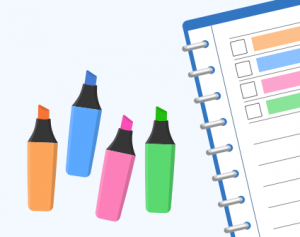Color coding is a great way to prioritize and understand your schedule in a single quick look. Time is a limited resource, and we must use it wisely to make the most of our day. It’s common to have a lot of tasks on your schedule, and you might easily get overwhelmed by the number of tasks piling up. One of the ways to conquer this issue is by color-coding. Here’s how to color code your tasks to increase productivity and quickly win the day.
Prioritize your schedule
Before you start color coding your tasks, you need to know how to create a prioritized schedule. Make a todo list, and figure out the important tasks – those that will make the most impact or bounded by time. Sort them by Critical, High, Medium, and Low priorities and set a realistic deadline for every task. Now after you have it all, you’re ready to begin color coding it.
Use color psychology
Knowing how colors affect our psychology makes it easier to assign the right color to tasks and keep the schedule organized. The main idea is to make sure colors work specifically for your needs. You can always use your own meaning for colors.
Specifying color to a task will set it apart from others and put your focus on the right things. Go over the list of colors below to learn more about which colors evoke a certain feeling and how you can use them to your advantage.
Color Coding: Red
Red is the color of energy, passion, and action. It’s bold and catchy, so it’s perfectly suited to be used as a color to catch our attention. Use it for any important tasks that you want to emphasize to the maximum, tasks that you would want to get done first.
Color Coding: Blue
Blue is the color of trust, responsibility, honesty, and loyalty. The best practice is to reserve it for more calm and relaxed tasks, it’s not drawing too much attention to save it for the tasks that you enjoy doing.
This can help you get into the mindset of knowing when to take a break and recharge.
Color Coding: White
The color white often represents purity, and new beginnings, like a clean canvas before drawing. One great way to use white is for tasks that you haven’t planned yet. In most apps that’s the default color of any new task, so you can keep the default white to highlight the tasks that aren’t fully planned.
Color Coding: Grey
Grey is often described as being a bland and unemotional color. But sometimes that’s exactly what we need. The grey color could be used for tasks that have a very low priority. For example, if you’re out of red tasks it could be a convenient time to focus on the non-essential grey tasks.
Color Coding: Purple
Purple relates to imagination, mystery, and spirituality. It makes a lot of sense to use it for tasks of a similar nature since purple is the combination of red and blue, and your creative tasks may also be of high priority and require you to feel relaxed, as for red and blue. Purple can also highlight tasks that require you to have a deep concentration session.
Color Coding: Green
Green is a color with balance and harmony. You can use green to apply to health or fitness-based tasks. Although it may not be as bold as red, it is still noticeable enough to remind you of why you should get certain tasks done. Whether it refers to health or other fitness activity, green is perfect to keep your attention fixed on the crucial areas of life.
Color Coding: Yellow
Yellow is a color that tends to evoke feelings of happiness, joy, and excitement. Many also consider it as a color that relates to acquired knowledge. Use yellow for items that happen less often but excite you and give you happiness.
Use an app to color code your tasks
Planndu is a personal task manager and daily organizer that helps you build a schedule and improve your productivity. Use Planndu’s vast variety of colors to code your tasks for any type of event. Simply press a selected task until the options menu appears. Choose ‘Change colors’ in the menu and select your preferred color. You could also highlight multiple items and set colors for all the selected tasks together.




